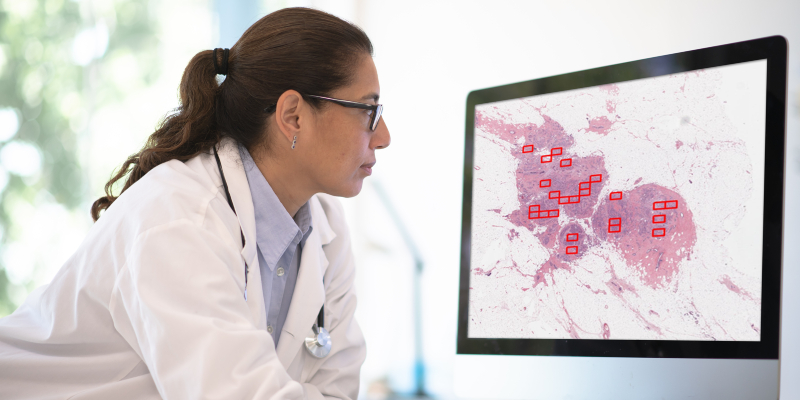
New technology which helps doctors more accurately diagnose breast cancer has been recognised by the US Food & Drugs Administration (FDA) for its exceptional potential clinical value.
The 4D Q-plasia OncoReader Breast uses digitised pathology slides of breast cancer tissue to diagnose disease with improved accuracy, effectively acting as an intelligent aid for clinical histopathologists. The FDA status means the product is now on a fast track to full market approval in the US and will boost progress to regulatory approval and clinical adoption in the UK and globally.
Developed through a three-year partnership between the University and 4D Path, a Boston company producing computer-aided cancer diagnostic products, the device has received FDA Breakthrough Device Designation.
The sought-after status is an acknowledgement by the FDA that a test, drug or device is a breakthrough in innovation and stands to improve the current standard of care for patients. It is one of the highest standards of a product's independent evaluation by a board of government experts and is recognised the world over.
"The inception of such a remote access diagnostic platform could be invaluable globally."
Dr Nic Orsi, Industrial Clinician Scientist in Histopathology at the Leeds Institute of Medical Research at St James's, has been leading the technology validation study at the University. He said: "This is a remarkable achievement which should bring significant benefits to patients."
Breast cancer diagnosis and treatment typically consists of a biopsy to diagnose the presence of cancer and its grade (a measure of how abnormal it appears and how aggressive it is likely to be), followed by surgery to remove it.
Today, surgery aims to be less aggressive and some patients receive chemotherapy before surgery, which reduces the availability of representative tumour tissue for diagnosis, therefore improving diagnostic accuracy using biopsies is increasingly important. Cancer grading is amended post-surgery in 20% of cases diagnosed by a histopathologist - but the device has reduced this rate to fewer than 5%.
Dr Orsi said: "Breast cancer remains a significant clinical problem, with one in eight women being affected in their lifetime.
"Improving diagnostic accuracy at the level of biopsies is becoming increasingly important considering changes in clinical practice based aimed at minimising the severity of surgical intervention.
"The inception of such a remote access diagnostic platform could be invaluable globally, particularly in developing countries with limited access to histopathology services."
Professor Andrew Hanby, NHS Consultant Breast Histopathologist at Leeds Teaching Hospitals Trust, said: "Pathologists are an essential part of the patient care pathway in offering a gold standard diagnosis to which patients' treatment is tailored.
"Unlike current rival AI methodologies, 4D Path's technology significantly augments and revolutionises the goal of achieving high levels of accuracy in diagnostics. It promises to enhance both the quality and efficacy of the process, giving patients the assurance that their treatment pathway has a solid and safe foundation."
The technology's advances and benefits have been welcomed by the cancer-specific Patient and Public Involvement (PPI) Group in Leeds, which said: "By accelerating the process and overcoming supplementary testing, both diagnostic costs and turnaround times would be significantly decreased, thereby reducing the financial burden on patients and healthcare providers.
"These developments are timely given the recognised national shortage of diagnostic histopathologists which are predicted to fail to meet the ever-growing clinical demands of an overstretched diagnostic service, nationally and globally."






